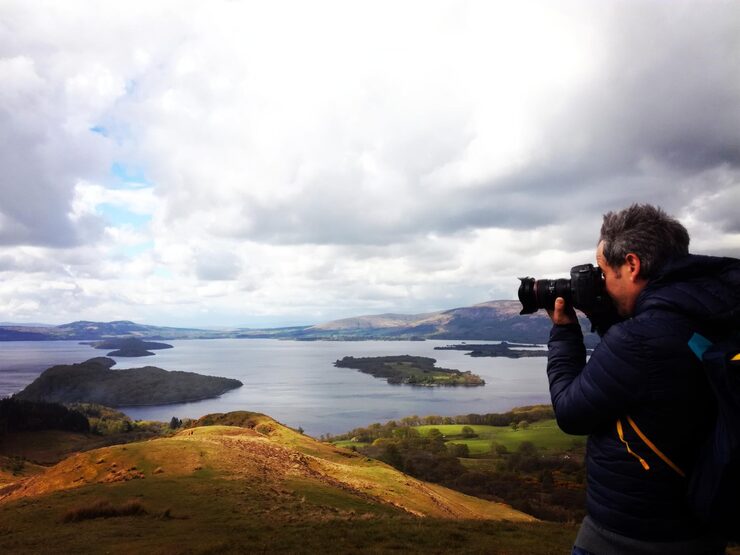Landscape photography techniques are more than just camera settings and pointing your lens at a scenic view. They are about learning to see the world differently, interpreting nature’s beauty, and capturing moments that tell a story. Whether it’s a glowing sunset over a mountain range or morning mist in a valley, using the right techniques transforms ordinary photos into works of art.
As a photographer, I remember my first hike to a hilltop where the sky turned crimson during twilight. My camera didn’t capture what my eyes saw. That’s when I realized the power of landscape photography techniques—understanding light, framing, and patience can make the difference between a snapshot and a masterpiece.
The Role of Composition in Landscape Photography Techniques
Composition is the backbone of compelling photography. Following rules like the rule of thirds, leading lines, or framing with natural elements creates balance. For example, a winding road leading into distant mountains gives the viewer’s eyes a natural path to follow.
Foreground interest is another vital technique. Adding rocks, flowers, or water reflections creates depth, making a flat photo come alive. These small adjustments separate amateur shots from professional images.
Mastering Light with Landscape Photography Techniques
Lighting determines mood and atmosphere. The golden hour, just after sunrise or before sunset, bathes landscapes in warm tones and long shadows. The blue hour, shortly after sunset, brings cooler tones perfect for dramatic skies.
Experienced photographers also use backlighting, where the sun sits behind a subject, creating silhouettes and glow effects. Learning to wait for the right light often matters more than expensive gear.
Essential Gear for Landscape Photography
While creativity is key, equipment enhances execution. Wide-angle lenses are favorites because they capture vast scenes. Sturdy tripods allow long exposures, especially useful for waterfalls or night skies. Filters, such as polarizers, reduce glare and make skies pop with contrast.
Even smartphones today can take incredible landscapes if you know how to compose and edit thoughtfully. Technology empowers everyone to explore landscape photography techniques without barriers.
Landscape Photography Techniques in Different Environments
Mountains require wide views and patience for the right light. Deserts, with their harsh sunlight and textures, benefit from early or late shooting. Forests present challenges with shadows but reward photographers with rich green tones and mystery.
Each environment demands adaptability. I once photographed coastal cliffs during stormy weather; instead of running for cover, I used the dramatic clouds and crashing waves to tell a story of raw power.
Storytelling Through Landscape Photography
Great landscapes do more than look pretty—they tell stories. A lone tree on a hill may symbolize resilience, while an empty path might spark curiosity about where it leads. By connecting emotionally with the scene, you create images that resonate with viewers.
This storytelling element elevates landscapes beyond documentation into the realm of art. With the right approach, your photos can evoke feelings of peace, awe, or adventure.
Post-Processing in Landscape Photography
Editing is not about faking reality but enhancing what you captured. Adjusting exposure, contrast, and color balance brings out the scene’s natural beauty. Programs like Lightroom or Photoshop offer control, but subtlety is key. Over-editing can strip away authenticity.
A well-edited landscape should look timeless, not artificial. Post-processing helps emphasize what you felt when pressing the shutter button.
Experts and Innovators in Landscape Photography
Throughout history, certain names have become synonymous with breathtaking landscapes. Ansel Adams revolutionized black-and-white landscapes, especially of Yosemite National Park. Galen Rowell blended adventure with photography, inspiring outdoor enthusiasts. Michael Kenna is known for his minimalist style, often using long exposures.
In today’s digital age, influencers and photographers like Peter Lik, Marc Adamus, and Elia Locardi carry the tradition forward. Each shows how landscape photography techniques continue to evolve with new technology and fresh perspectives.
The Patience Behind the Perfect Shot
One of the least discussed but most important techniques is patience. Sometimes it takes hours, or even days, to get the right weather, light, or atmosphere. Waiting in silence, observing nature, and syncing with its rhythm is part of the process.
Some of my most memorable photos came after waiting for the fog to clear or the rain to pause. That patience is what makes landscapes so rewarding—they remind us to slow down.
Why Landscape Photography Inspires People
Landscape images are universal. They transcend languages and cultures, offering people everywhere a glimpse of the earth’s beauty. They inspire travel, conservation, and appreciation for nature.
From Instagram feeds to art galleries, landscapes captivate audiences. Behind each image lies the passion of a photographer using landscape photography techniques to share their perspective of the world.
Read also:
sri lanka national cricket team vs afghanistan national cricket team match scorecard
afghanistan national cricket team vs england cricket team timeline
afghanistan national cricket team vs south africa national cricket team matches
australian men‘scricket team vs new zealand national cricket team match scorecard
